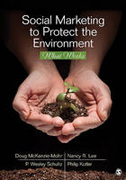
Social marketing to protect the environment: what works
McKenzie-Mohr, Doug
Kotler, Philip
Schultz, Paul W.
Lee, Nancy R.
Social marketing takes key marketing principles and applies them to campaignsand efforts to influence social action. In Social Marketing to Protect the Environment, the focus turns to the environment, and how social marketing can besuccessful to change environmental behaviour. The text begins with a definition of the Social Marketing Model and includes a discussion of various tools that can be used to develop social marketing strategies. It then moves into sections on Residential-Related Behaviours and Commercial-Related Behaviours. These sections follow a consistent format and: - Describe a variety of environmental issues - Give examples of the numerous changes in behaviours and/or practices that would contribute to reducing the problem - Provide mini-cases that illustrate the successful use of social marketing principles along with tools to influence this behaviour in similar situations - Review what worked and what could have been improved. A final section provides future directions and recommendations. ÍNDICE: Foreword Preface Section I: Introduction Chapter 1: Introduction: Fostering Sustainable Behavior Section II: Influencing Behaviors in the Residential Sector Chapter 2: Reducing Waste The Problem Potential Behavior Solutions Case: No Junk Mail (Bayside, Australia) Case: Decreasing Use of Plastic Bagsand Increasing Use of Reusable Ones (Ireland) Case: Increasing Curbside Recycling of Organics (Halifax, Nova Scotia) Other Notable Programs Summary Questions for Discussion References Chapter 3: Protecting Water Quality The Problem Potential Behavior Solutions Case: Influencing Natural Yard Care (King County, Washington) Case: Scooping the Poop (Austin, Texas) Other Notable Programs Summary Questions for Discussion References Chapter 4: Reducing Emissions The Problem Potential Behavior Solutions Case: Anti-Idling: Turn it Off (Toronto, Canada) Case: TravelSmart (Adelaide, South Australia) Other Notable Programs Questions for Discussion Summary References Chapter 5: Reducing Water Use The Problem Potential Behavior Solutions Case: Reducing Water Use (Durham Region, Canada) Case: Ecoteams (United States, Netherlands, United Kingdom) Other Notable Programs Summary Questions for Discussion References Chapter 6: Reducing Energy Use The Problem Potential Behavior Solutions Case: The One Tonne Challenge to Reduce Greenhouse Gas Emissions (Canada) Case: ecoENERGY to Promote Home Energy Efficiency (Canada) Other Notable Programs Summary Questions for Discussion References Chapter 7: Protecting Fish and Wildlife Habitats The Problem Potential Behavior Solutions Case: Reducing Deliberate Grass Fires (Wales, United Kingdom) Case: Planting Eastern Shore Natives (Virginia) Case: Seafood Watch: Influencing Sustainable Seafood Choices (United States) Other Notable ProgramsSummary Questions for Discussion References Section III: Influencing Behaviors in the Commerical Sector Chapter 8: Reducing Waste The Problem Potential Behavior Solutions Case: Green Dot, Europe's Packaging Waste Reduction Case: ForkIt Over: Reusing Leftover Food (Portland, Oregon) Case: Anheuser-Busch: An EPA WasteWise Hall of Fame Member Other Notable Programs Summary Questions for Discussion References Chapter 9: Protecting Water Quality The Problem PotentialBehavior Solutions Case: Chuyen Que Minh, Reducing Insecticide Use Among RiceFarmers (Vietnam) Case: Dirty Dairying (New Zealand) Other Notable Programs Summary Questions for Discussion References Chapter 10: Reducing Emissions The Problem Potential Behavior Solutions Case: Bike Sharing Programs Case: ATT's &Nortel's Telework Programs (United States, Canada) Other Notable Programs Summary Questions for Discussion References Chapter 11: Reducing Water Use The Problem Potential Behavior Solutions Case: Conserving Water in Hotels (Seattle, Washington) Case: Fighting the Water Shortage Problem in Jordan Other Notable Programs Summary Questions for Discussion References Chapter 12: Reducing Energy Use The Problem Potential Behavior Solutions Case: Using Prompts to Turn Off Lights (Madrid, Spain) Case: Norms-based Messaging to Promote Hotel Towel Reuse (California) Other Notable Programs Summary Questions for Discussion References Chapter 13: Concluding Thoughts and Recommendations
- ISBN: 978-1-4129-9129-2
- Editorial: Sage Publications
- Encuadernacion: Rústica
- Páginas: 256
- Fecha Publicación: 01/06/2011
- Nº Volúmenes: 1
- Idioma: Inglés
